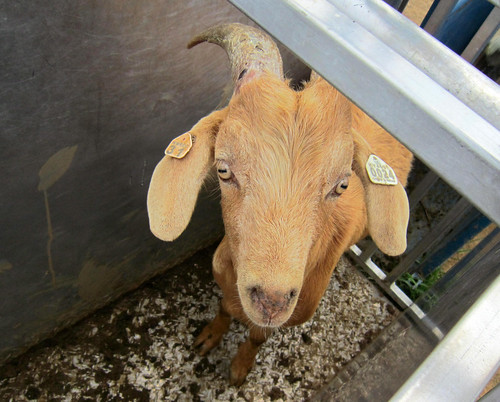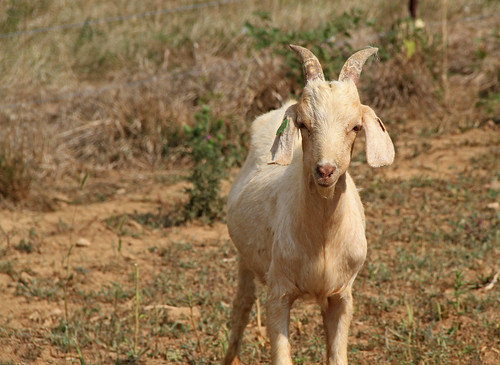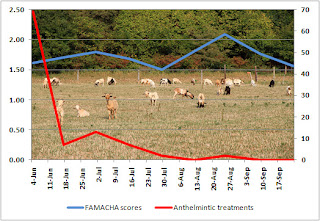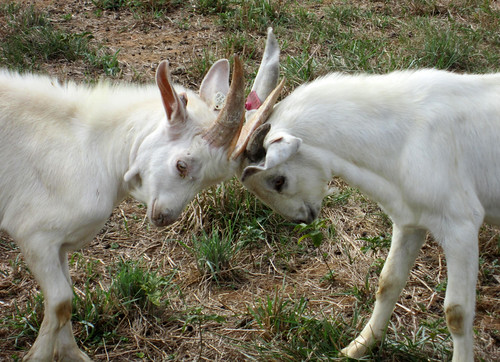Pooled fecal samples were collected every four weeks. On September 9, the bucks were scanned to determine carcass characteristics. They were evaluated for reproductive soundness and structural correctness. Data collection was made as consistent as possible.
On June 4-5, the 72 goats that started the test ranged in weight from 31 to 75 lbs. (14.1 to 34.0 kg) and averaged 44.1 lbs. (20 kg). After a 12-day adjustment period in which the goats gained an average of 1.7 lbs (or 0.142 lbs. per day), the goats were reweighed to determine starting weights.
On June 17, starting weights ranged from 32 to 74 lbs. (14.5 to 33.6 kg) and averaged 44.4 lbs. (20.2 kg). For the 100-day duration of the test, the 67 goats that finished the test gained from -1 to 24 lbs. (-0.5 to 10.9 kg) and averaged 12.1 lbs. (5.5 kg). On September 23, ending weights ranged from 31 to 81 lbs. (14.1 to 36.8 kg) and averaged 58.2 lbs. (26.5 kg)
ADG ranged from -0.01 to 0.24 lbs. (4.5 to 109 g) per day and averaged 0.121 lbs. (55 g) per day. The goats gained the most weight during the first weight period, from June 17 until July 1, when the forage was the most abundant and temperatures were still below 95ºF. They gained 0.315 lbs. (143.2 g) per day during this period.
The second highest rate of gain was during the sixth weigh period (August 25-September 9) when the goats gained nearly as much at 0.313 lbs. (142.3 g) per day. Much of this was compensatory gain, as the goats were given access to a "fresh" pasture and they began eating some hay. Previously, they refused to eat supplemental hay. They never consumed anything from the three protein tubs.
The only weigh period in which the goats lost weight was the 5th period (August 12-25) when the goats lost an average of 0.083 lbs. (37.7 g) per day. In fact, during the month of August, the goats had practically no forage to eat. As mentioned in previous blog entries, the goats did incredibly well this year when you consider the extreme drought and record high temperatures. Other species of livestock would not have fared nearly as well.
Usually, the goats lose weight during the last two week period, due to the rut. This is especially true with the bigger, more mature and dominant bucks. Last year, the bucks lost an average of 0.221 lbs. (100.5 g) per day. This year, (on-average) they maintained their weight. A way to reduce the effect of the rut would be to move the test several weeks early. Start two weeks earlier; end two weeks earlier.
Fecal egg counts
Individual fecal samples were sent via overnight mail to Dr. Dahlia O'Brien's lab at Delaware State University. Individual fecal egg counts were determined using the Modified McMaster Technique. A two-chambered McMaster slide reduces the variation in the data.
At the start of the test, all of the goats are dewormed with anthelmintics from two different drug families. This year, moxidectin (Cydectin® injectable) was administered (as an injection) at the cattle dose. Because levamisole was not available, the other anthelmintic administered was albendazole. The Valbazen® sheep drench was administered orally at 2x the sheep dose.
The purpose of giving two dewormers at the start of the test (independent of the need for deworming) is to make sure all of the goats start the test equally and (relatively) free from parasite infection. Unfortunately, this year's double-dosing only reduced egg counts by 28 percent. In year's past, the initial dewormings (which always included levamisole) reduced egg counts by more than 95 percent.
While some high fecal egg counts were observed during the test, egg counts were low throughout most of the testing period, averaging less than 500 epg from July 15 until the end of the test. The pathogenic burden of the barber pole worm is 2,000 epg. In the test, the (Gold) performance standard for average fecal egg count is < 500 epg.
Most of the high egg counts were likely due to pre-existing worm infections and possible anthelmintic failure. Only one of the top-gaining goats failed to meet the performance standards for parasite resistance (fecal egg counts).
Pooled samples
Pooled samples were sent via overnight mail to Dr. Ray Kaplan's lab at the University of Georgia College of Veterinary Medicine. With the exception of Nematodirus, all strongyle (roundworm) eggs look the same when observed under a microscope. As a result, the eggs must be hatched to identify the type of worm (from the larvae). Fecal coproculture showed the worm burden to be 100 percent barber pole worm (Haemonchus contortus).
The only fecal coproculture that showed a significant amount of other worm species was the sample collected on June 5. This made sense as the goats arrived from many different farms and states. The June 5 sample was composed of 80% Haemonchus, 15% Trichostrongylus, and 5% Nematodirus.
Coccidia oocysts were frequently observed in the fecal samples (individual and pooled), but this was of no real significance, as the goats were treated for coccidiosis upon arrival and their minerals contained a coccidiostat. Clinical coccidiosis was not observed in any of the goats. Higher dag scores were attributed primarily to dietary causes.
Tapeworm eggs were sometimes noted in the fecal samples. At the beginning of the test, tapeworm segments were seen in some feces. Except in extreme cases, tapeworms are not considered to be pathogenic in small ruminants. Immunity is developed relative early in life.
FAMACHA© scores
Because the worm load was (almost) all barber pole worm, the FAMACHA© system was especially effective for monitoring and controlling internal parasites in the 2010 test. Body condition, coat condition, and dag scores were also determined to support the decision-making process. When fecal egg count data (from two weeks prior) was available, it was also factored into deworming decisions.
Goats with FAMACHA© scores of 4 and 5 are always dewormed in the test. Goats with FAMACHA© scores of 1, 2 or 3 are usually not. However, this year, because of the possible anthelmintic failure, goats with FAMACHA© scores of 3 were also dewormed during the early part of the test Once levamisole was obtained for the test, goats with FAMACHA© scores of 3 were no longer dewormed. The test data showed that levamsiole was clearly the most effective anthelmintic in this year's test, among this year's goats.
While some few goats struggled with Haemonchus at the beginning of the test, few goats required deworming during the test period. The twenty treatments that were administered on July 1 and July 15 were mostly cautionary, given to goats with FAMACHA© scores of 3. Two-thirds of the goats (n=42) did not require deworming during the test. Only one of the top-gaining goats failed to meet the standards for parasite resilience (FAMACHA© scores and number of anthelmintic treatments).
This year's extreme weather conditions were not conducive to the development of the barber pole worm and similar worm parasites. While high temperatures lead to faster development of worm larvae, without rainfall, such temperatures are inadequate for successful development. On the other hand, the close grazing caused by the extreme drought, could cause some goats to ingest some infective worm larvae.
Carcass evaluation
At least ten goats from the test will be harvested to collect actual carcass data. The challenge to carcass evaluation is finding buyers for the meat. According to last year's carcass data, a goat will yield approximately 25 percent of its live weight in boneless, fat-free meat. Last year, yield ranged from 21.5 to 30.7 percent. Yield is higher when the carcass is processed for (bone-in) retail cuts.
Purpose
The purpose of the Western Maryland Pasture-Based Performance Test is to evaluate the performance of meat goats consuming a pasture-only diet with natural exposure to internal parasites, primarily the barber pole worm. Because all of the goats are being raised in the same environment, the differences observed in a central performance test can be attributed mostly to genetic differences.
You cannot compare goats from this year's test to goats in last year's test (or any other year). Every year of the test is different. Different environmental conditions occur each year. The goats are different, as is the dynamic of the herd. You cannot compare the goats in this test to the goats in another test or on a farm. The only way to compare goats from one farm to another is to put them in a performance test (like this one) or submit data for EPDs (expected progeny differences) via NSIP/LP.
The data collected in the test should help producers make selection and buying decisions. That is the purpose of performance testing. Questions about the data (and test) should be directed to Susan Schoenian at (301) 432-2767 x343 or sschoen@umd.edu or any member of the Goat Test Team. Team members are listed in the right hand column of this blog.
Next year
Another test will be conducted in 2011. During the next several months, consignors (and others) will be solicited for their input regarding next year's test. The test is open to male goats of any breed, 3 to 5 months of age, weighing between 35 and 70 lbs.


















